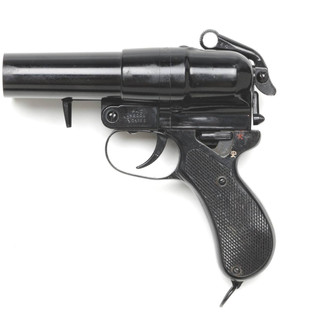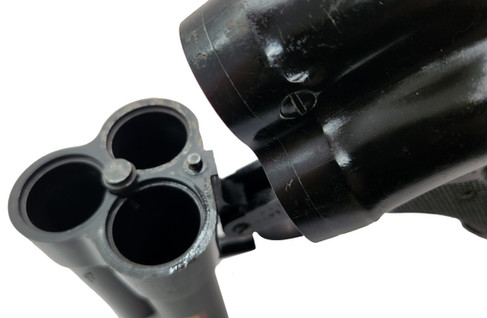Imperial Japanese Navy Type 90 Flare Gun: Double and Triple Barrel Flare Pistol.
- Patrick Phillips
- Sep 30, 2023
- 4 min read

Origins.
One of the most unique pieces of Japanese militaria to exist, and certainly an oddity from any nation’s perspective, is the Japanese Type 90 triple-barrel flare pistol. Being the only triple-barreled flare pistol ever built, they stand out among Japanese collections. The Japanese navy adopted its first flare pistol in the 1927; this first flare pistol being a double-barreled 28mm hammer fired flare pistol manufactured by the Kayaba Kogyo company. Resembling a short double barrel shotgun, these early naval flare pistols featured double hammers, double triggers, and a rounded grip.

Development and operation.
Development quickly moved forward at Kayaba and a new design, the Type 90, was adopted by the Imperial Japanese Navy in 1930 (2590 in the Japanese calendar). The Type 90 would retain many of the features of the previous Kayaba, but with major improvements. The most significant change was the redesign of the grips and frame of the pistol. The main complaint about the Kayaba pistol was the grip. Its highly curved design did not fit the hand well and made recoil hard to handle. The new Type 90 would move away from the highly curved grip design of the Kayaba and adopt a more straight and ergonomic grip style. The frame was also designed in such a way that the barrels could move rearward independently of the grip by about 3/4 of an inch or 19mm. This allowed for improved recoil absorption and control of the pistol during firing. The barrels would be pushed back forward by a spring located in the grip. The Type 90 featured a ‘pull-forward’ rod for opening the action, similar to the earlier Kayaba. Three distinct styles of opening rod can be found on the Type 90. The earliest style is a curved hook, later straight hooks and a crescent shaped lever were developed. The double barrel Type 90’s are cocked by pulling a lever at the rear of the pistol straight backwards. The barrel could be selected by rotating a lever at the back of the pistol.

Two years later, the iconic three-barreled version of the Type 90 would enter Japanese navy service and would retain the same Type 90 designation. Most features of the three-barreled Type 90 would carry over from its double-barreled predecessor, with some important changes. The first is obviously the addition of a third barrel, but the most significant change is internal. The double-barrel Type 90 is cocked with a lever. This lever essentially pulls the firing pins rearward until they are caught by a sear. The triple-barrel Type 90 uses a plate that holds the three firing pins in their location and arranged around a center hole with helical cuts. This center hole almost resembles rifling. A center post with a helical gear mounts inside this plate and runs through the rear cover where it attaches to the cocking lever. When the cocking lever is rotated counterclockwise, the helical gears move the firing pins rearward until they are caught by their individual sear. The barrel assembly hinges forward to allow for loading, similar to a break action shotgun. Flare cartridges are extracted by a round spring-loaded plunger in the center of the assembly that pushes all three cartridges out about ¼ inch or 6.5mm. The individual cartridges can then be pulled out by hand.

The grip frame contains the trigger, safety, and internal springs to move the barrels forward after firing. The Type 90 safety on both the two and three-barreled versions is two position and located on the left-hand side of the pistol, up being “fire” and down being “safe”. Each position is marked with its corresponding Kanji character. The base of the pistol grip features a swivel lanyard loop. Early two and three barreled Type 90’s would have wood grips but were later replaced by hard black plastic grips.

Markings.

The triple-barrel Type 90 is marked on the right side with the Kayaba Kogyo company logo and serial number. The left side of the pistol lists the Japanese patent number with the markings “PAT. NO. 93006”. The safety lever is also marked with the serial number. The top of the pistol is marked with a cherry blossom, the Kayaba Kogyo company logo, a factory inspection stamp, and an anchor. The anchor stamp would be applied to the pistol once it was accepted into Imperial Japanese Navy service. Interestingly, the cocking lever is also marked on the right side with the Kayaba Kogyo company logo.
The Type 90’s most distinct markings are the color-coded barrels. These markings indicate which colored flare was loaded into each barrel. The left barrel is marked with a yellow band and two red stripes, the top barrel is white, and the right barrel is marked with two green stripes. The early triple barreled flare guns had these color-coded markings painted on them, and later ones were decals applied to the barrels. One of the primary purposes of the triple-barrel version so that messages could be sent or responded to quickly, and each color would represent a certain message. Having the barrels preloaded would allow the user to quickly select the proper flare color and send his message or acknowledge a message he received. This would eliminate the need to load the proper flare and allow for easy selection at night.
Cartridges.

The Type 90 used the same 28mm cartridge as the original double barrel Kayaba flare pistol. Early flare cartridges were entirely brass. Later, cardboard shells with brass and steel bases were adopted for use. Two primary types of flare cartridges were used, smoke and star cluster flares. In Japanese, these are referred to as “Dragons” (smoke), and “Stars” (star cluster). Dragon and star flares are typically found with cardboard shell bodies that are colored to match the type of signal they are for easy identification in daylight. Common colors observed are white, yellow, red, blue, green, and black. Dragon flares are enclosed on the end with a plug of thin cardboard and the Kanji character ( 龍 )for dragon. Star cluster flares lack any Kanji marking on the case plug and are instead filled with wax for water resistance. Flare cartridges could be carried by a canvas bandolier that held 18 flares. These bandoliers can be found with brass and steel buckles.


Legacy
In all, roughly 5300 Type 90 flare pistols were produced with about half of them being the triple barreled variant. They served the Japanese navy well all the way until the end of the second World War. Both the double and triple-barreled versions are quite interesting and are often the centerpiece of a Japanese militaria collection.












Comentarios